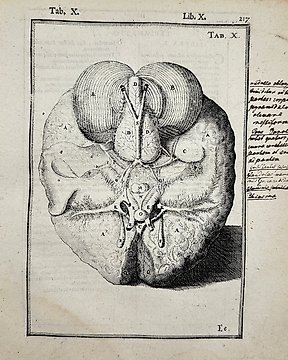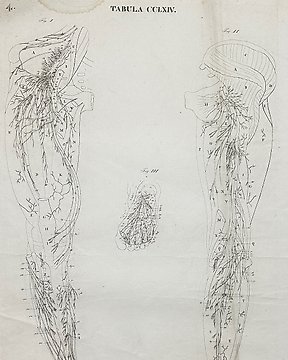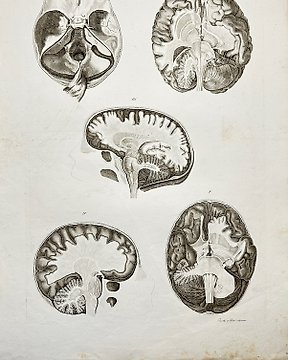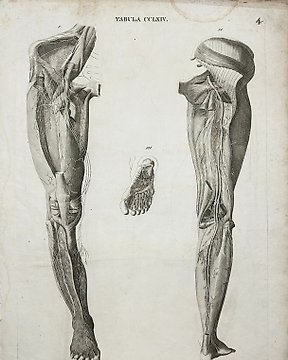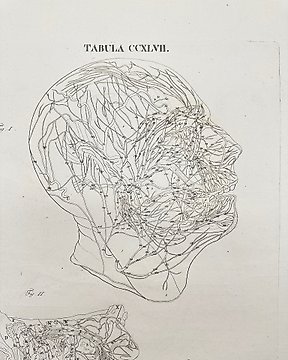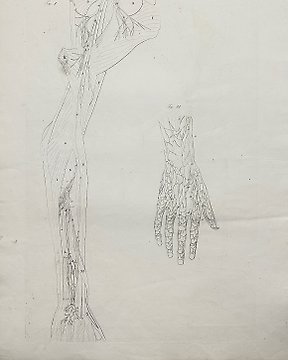Wonderful item perfectly described
Übersetzung ansehenJean Louis Alibert - Clinica ...... overo Trattato compiuto delle malattie della pelle - 1835
Nr. 84626541



THE FOUNDATION OF DERMATOLOGY !!!
Jean-Louis-Marc ALIBERT (1768-1837): Clinica del parigino ospedale di S. Luigi ossia trattato compiuto delle malattie della pelle contenente la descrizione di queste infermità ed i loro migliori metodi curativi del barone G.L. Alibert ... Traduzione italiana di M. G. Levi ... Venezia, co’ tipi dell’editore Giuseppe Antonelli, 1835
§ Imperial folio (485 x 330); XXVIII, 408 pp., 63 HAND-COLURED PLATES by G. Buttazzon, M. Zuliani and Moretti, depicting skin diseases. Unimportant foxing in places. Good copy
First Italian edition, first published in French in 1806. Alibert, physician to Louis XVIII and chief physician of the Hôpital St. Louis, is considered the founder of French dermatology. Author of several works, he described several conditions and coined terms (such as syphilid, keloid, dermatosis) which are still in use today. Some skin affections are also named after him, for example Alibert mentagra (Sycosis barbae), Alibert disease (False keloid), Alibert-Bazin syndrome (Mycosis fungoides). Remarkable also the iconographic apparatus of the work, were the hand-colored plates are of both medical and artistic relevance. “The seminal works of Alibert, like other skin atlases containing hand-drawn portraits from the 19th century, reveal not only a detailed examination of skin disease but sometimes also occupational afflictions associated with the patient subject. Alibert's opus on pictorial dermatology becomes not only an elaborate work but also a reflection of the socioeconomic status and health of his patients ...” (Long). The translation into Italian is by the Italian physician Moisé Giuseppe Levi (1796-1859); he translated several medical works from the French, and wrote himself some essay, for one of which, on aneurysms, was awarded a prize from the Royal Academy of Naples. “Mosé Giuseppe Levi ... was in fact the main protagonist of the compilation and diffusion of the medical Dizionari. ... Levi was a good practitioner, but he gained a high reputation as an even better translator and journalist.” (Conforti).
TATIANA NINKOV and MIKE CADOGAN Jean-Louis Alibert In: LITFL - Life in the FastLane, https://litfl.com/jean-louis-alibert/, Accessed on May 25, 2023; VALENCIA LONG The life and art of Alibert's dermatology In: Clinics in Dermatology Volume 40, Issue 3, May-June 2022, Pages 293-296; GARRISON MORTON 3986; Heirs of Hippocrates 1219 (both about the first edition); ISIDORE SINGER, FREDERICK T. HANEMAN Levi, Mose Giuseppe In: Jewish Encyclopedia; MARIA CONFORTI Creating Italian medicine. Language, politics and the Venetian translation of three French medical dictionaries in the early 19th century In La Révolution française [online], 13 - 2018, published 22 January 2018, http://journals.openedition.org/lrf/1964
THE FOUNDATION OF DERMATOLOGY !!!
Jean-Louis-Marc ALIBERT (1768-1837): Clinica del parigino ospedale di S. Luigi ossia trattato compiuto delle malattie della pelle contenente la descrizione di queste infermità ed i loro migliori metodi curativi del barone G.L. Alibert ... Traduzione italiana di M. G. Levi ... Venezia, co’ tipi dell’editore Giuseppe Antonelli, 1835
§ Imperial folio (485 x 330); XXVIII, 408 pp., 63 HAND-COLURED PLATES by G. Buttazzon, M. Zuliani and Moretti, depicting skin diseases. Unimportant foxing in places. Good copy
First Italian edition, first published in French in 1806. Alibert, physician to Louis XVIII and chief physician of the Hôpital St. Louis, is considered the founder of French dermatology. Author of several works, he described several conditions and coined terms (such as syphilid, keloid, dermatosis) which are still in use today. Some skin affections are also named after him, for example Alibert mentagra (Sycosis barbae), Alibert disease (False keloid), Alibert-Bazin syndrome (Mycosis fungoides). Remarkable also the iconographic apparatus of the work, were the hand-colored plates are of both medical and artistic relevance. “The seminal works of Alibert, like other skin atlases containing hand-drawn portraits from the 19th century, reveal not only a detailed examination of skin disease but sometimes also occupational afflictions associated with the patient subject. Alibert's opus on pictorial dermatology becomes not only an elaborate work but also a reflection of the socioeconomic status and health of his patients ...” (Long). The translation into Italian is by the Italian physician Moisé Giuseppe Levi (1796-1859); he translated several medical works from the French, and wrote himself some essay, for one of which, on aneurysms, was awarded a prize from the Royal Academy of Naples. “Mosé Giuseppe Levi ... was in fact the main protagonist of the compilation and diffusion of the medical Dizionari. ... Levi was a good practitioner, but he gained a high reputation as an even better translator and journalist.” (Conforti).
TATIANA NINKOV and MIKE CADOGAN Jean-Louis Alibert In: LITFL - Life in the FastLane, https://litfl.com/jean-louis-alibert/, Accessed on May 25, 2023; VALENCIA LONG The life and art of Alibert's dermatology In: Clinics in Dermatology Volume 40, Issue 3, May-June 2022, Pages 293-296; GARRISON MORTON 3986; Heirs of Hippocrates 1219 (both about the first edition); ISIDORE SINGER, FREDERICK T. HANEMAN Levi, Mose Giuseppe In: Jewish Encyclopedia; MARIA CONFORTI Creating Italian medicine. Language, politics and the Venetian translation of three French medical dictionaries in the early 19th century In La Révolution française [online], 13 - 2018, published 22 January 2018, http://journals.openedition.org/lrf/1964
- 4
- 1
- 0
Very citified
Übersetzung ansehenTutto bene, grazie.
Übersetzung ansehenNão era precisa, nem completa, a descrição feita.
Übersetzung ansehenPerfetto
Übersetzung ansehen- 4
- 1
- 0
Wonderful item perfectly described
Übersetzung ansehen
